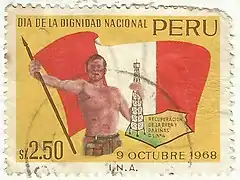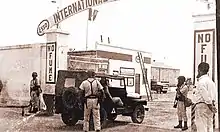Day of National Dignity
The Day of National Dignity was a holiday that was celebrated in Peru every October 9 in commemoration of the capture of La Brea and Pariñas by Revolutionary Government of the Armed Forces, the left-wing military junta that controlled the country at the time.[1]
| Day of National Dignity | |
|---|---|
 Conmemorative stamp | |
| Observed by | Peru (until 1980) |
| Significance | Expropriation of La Brea y Pariñas by the Revolutionary Government |
| Date | 9 October |
| First time | 9 October 1968 |
| Related to | Revolutionary Government of the Armed Forces |
History

On October 9, 1968, the government of General Juan Velasco Alvarado emerged six days earlier by a coup against President Fernando Belaúnde, decided to solve the "Problem of La Brea and Pariñas" by nationalizing the oil industry. Through Decree Law No. 417066[2] and the military deployment of the First Military Region based in Piura, the government of the so-called Peruvian Revolution took the La Brea and Pariñas oil fields and the Talara refinery, in the hands of International Petroleum Company (IPC).[3] The government expropriated the assets of the US company and expelled it from the country, although the IPC was later compensated.[4]
The seizure of the facilities was officially announced the same day by a recorded message to the nation. The government officially baptized the date as the Day of National Dignity. With this action, the Revolutionary Government established itself in power and reoriented state policy towards the restitution of national sovereignty at the economic level and the recovery of oil for the interests of the nation.[5]
After the Tacnazo of 1975 led by General Francisco Morales Bermúdez, the date fell out of use. The celebration was finally withdrawn from the national civic calendar when democracy was restored with the 1980 elections.[5]
References
- Sánchez, Juan Martín (2002). La revolución peruana: ideología y práctica política de un gobierno militar, 1968-1975. University of Seville. p. 153. ISBN 978-84-00-08051-8.
- Complejo Industrial de Talara, Refinería, Instalaciones y Anexos son Expropiados por el Gobierno Revolucionario de la Fuerza Armada. DECRETO LEY Nº 4 17066 (PDF). Ministry of Justice. 1968.
- Sucedió en el Perú - Juan Velasco Alvarado. TV Perú. 2016-10-17.
- Contreras, Carlos (2016). Crisis y reforma. Restauración oligárquica y nuevos actores (1948-1968). Historia del Perú republicano (in Spanish). Lima: Editorial Septiembre. p. 46. ISBN 978-612-308-176-8.
- "A 50 años de la nacionalización de la Brea y Pariñas, Talara sigue olvidada". La República. 2018-10-08.
- "Autoridades celebran el Día de la Dignidad Nacional". Municipality of Talara. 2017-10-09.
- "Celebran día del trabajador petrolero y 50 años de la toma de la Brea y Pariñas". El Regional de Piura. 2018-10-10.
- Fernández, Fernando (2015-10-08). "Piura: En Talara celebran el día de la Dignidad Nacional". Diario Correo.